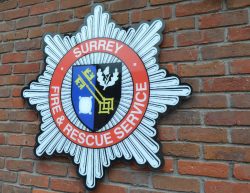 Abraham Lincoln
If given the truth, the people can be depended upon to meet any national crisis...
Abraham Lincoln
If given the truth, the people can be depended upon to meet any national crisis...
 Guildford news...
for Guildford people, brought to you by Guildford reporters - Guildford's own news service
Guildford news...
for Guildford people, brought to you by Guildford reporters - Guildford's own news service
Fire Service Still Requires Improvement in All Key Areas, says Inspectorate
Published on: 16 Dec, 2021
Updated on: 17 Dec, 2021
local democracy reporter
Surrey Fire and Rescue Service still requirements improvement three years after its last inspection, an inspectorate has said.
The service still needs to get better at looking after its people and also in its effectiveness and efficiency, although efficiency was no longer rated “inadequate” in an assessment report out today (December 15).
Her Majesty’s Inspector of Fire & Rescue Services, which inspected Surrey Fire and Rescue Service (SFRS) a few months ago, said today it is in “much better shape”, with several areas for improvement identified but no new causes for concern.
Its transformation plan, which began being implemented in March 2020, was described as “effective”.
Inspector Matt Parr said: “It was very heartening to see the progress made by Surrey Fire and Rescue Service.
“The service knows that there is a great deal of work to do to change and improve its organisational culture, but it is approaching this challenge positively.”
But the Fire Brigade Union (FBU) said “the idea that progress has been made is ridiculous” and morale in the service is at an “all-time low”.
How effective is the service at keeping people safe?
The service needs to make sure it gives firefighters up-to-date and useful information about the risks they might face, in particular buildings, for example.
The inspection found 51 per cent of risk information about premises was out of date.
The service has a much greater focus on preventative work and is now said to be good at preventing fires, but should evaluate this work so it understands what works.
In terms of responding to fires, last time the inspector said the service needed to improve how it responds because it had reduced its workforce over time but not adjusted its way of working accordingly.
The inspector was pleased that since then it has developed a new way of working with its “Making Surrey Safer Plan” reviewing where stations, fire engines and response staff are located. This has been externally scrutinised.
Home Office data shows that in the year up to the end of March 2020, the service’s response time was nine minutes 49 seconds. This is slower than the average for services such as Surrey that cover both urban and rural areas.
SFRS has 30 fire engines but whether or not they can all be used depends on the staff available. The report says average availability in 2020/21 was 68 per cent, which compares with an 83 per cent average in England.
It says the service has appropriately trained its incident commanders and assesses them every two years.
However the service should ensure it has an effective system for learning from operational incidents.
How efficient is the service at keeping people safe?
The service’s budget for 2021/22 is £31.7 million, the same as the previous year. At the last inspection, the service was being asked to provide a further £6 million in savings but this is no longer the case.
Last time it relied too much on overtime working to keep fire engines available, which was not financially sustainable. Now the inspector was pleased to see overtime being used far less.
Leaders say they did this by auditing overtime use and changing shift patterns “to ensure staff were on duty when they were needed most”.
The inspector said the Making Surrey Safer Plan better-targeted resources at areas of highest risk.
SFRS has improved its approach to collaboration and is saving about £600,000 a year after setting up a joint control room with West Sussex Fire and Rescue Service.
It needs to make sure it evaluates the end results of its collaborations.
in 2019/20 Surrey was among the lowest services in the country for the number of safe and well visits carried out per head of population.
How well does the service look after its people?
The Making Surrey Safer Plan led to a period of significant change including moving some night-time cover over to daytime, longer daytime shifts and transferring some frontline roles to prevention work and all of this has caused tension in industrial relations.
The report says relationships between senior leaders and operational staff remain challenging.
Staff reported they did not always feel engaged in decisions that affect them.
Leaders are visiting fire stations weekly to hear concerns but firefighters said they did not always get feedback on problems raised.
The report says the service has improved its grievance procedures since the last visit but needs to do more to understand and address bullying and harassment.
A lead for equality, diversity and inclusion has been appointed though more needs to be done to improve diversity in the workforce and at all levels of management, which has not been improved by recent recruitment.
It has 2.2 per cent Black, Asian and minority ethnic firefighters compared to 9.6 per cent of the local population.
How have the fire service and union responded?
Chief fire officer Steve Owen-Hughes said: “I am extremely proud of the hard work happening within our service and want to thank all of my colleagues in the service. I think the latest report acknowledges the vast amount of improvements that have taken place.
“It also recognises that, at the time of the inspection, we still had over two-and-a-half years of further planned improvements left to deliver.
“We always welcome these reports, because they help us to ensure we are on track to deliver our public purpose – to keep people safe. They also help us recognise some areas that need more focus and we have already started working on these.”
Joe Weir, FBU regional secretary for the South East, said: “We are at an absolute crisis point, and this report, whilst containing some recognition of shortfalls, does not go far enough in identifying this.
“The idea that ‘progress’ has been made since 2018, the point of the last inspection, is ridiculous.”
He pointed to an East Horsley house fire at around 6am last month where the first fire engine took nearly 13 minutes to arrive and the elderly man they rescued later died. The nearest station at Painshill had been made daytime only.
Mr Weir added: “Morale in Surrey Fire and Rescue is at an all-time low, and no wonder – firefighters want to be proud of the service they provide to their community.”
Recent Articles
- Guildford Institute’s Crowdfunding Project for Accessible Toilet in its New Community and Wellbeing Centre
- Letter: Guildford – Another Opportunity Missed?
- Letter: GBC’s Corporate Strategy – Where Is the Ambition?
- My Memories of John Mayall at a Ground-breaking Gig in Guildford Nearly Six Decades Ago
- Westborough HMO Plans ‘Losing the Heart of the Street’ Says Resident
- College Invests to Boost Surrey’s Economy and Close Digital Skills Gap
- Community Lottery Brings Big Wins for Local Charities
- GBC Housing Plan Promises ‘A Vibrant Urban Neighbourhood’ Near Town Centre
- Hospital Pillows ‘Shortage’ at the Royal Surrey
- Updated: Caravans Set Up Camp at Ash Manor School


Search in Site
Media Gallery
Dragon Interview: Local Artist Leaves Her Mark At One of England’s Most Historic Buildings
January 21, 2023 / No Comment / Read MoreDragon Interview: Lib Dem Planning Chair: ‘Current Policy Doesn’t Work for Local People’
January 19, 2023 / No Comment / Read MoreA3 Tunnel in Guildford ‘Necessary’ for New Homes, Says Guildford’s MP
January 10, 2023 / No Comment / Read More‘Madness’ for London Road Scheme to Go Ahead Against ‘Huge Opposition’, Says SCC Leader
January 6, 2023 / No Comment / Read MoreCouncillor’s Son Starts Campaign for More Consultation on North Street Plan
December 30, 2022 / No Comment / Read MoreCounty Council Climbs Down Over London Road Works – Further ‘Engagement’ Period Announced
December 14, 2022 / No Comment / Read MoreDragon Interview: GBC Reaction to the Government’s Expected Decision to Relax Housing Targets
December 7, 2022 / No Comment / Read MoreHow Can Our Town Centre Businesses Recover? Watch the Shop Front Debate
May 18, 2020 / No Comment / Read More











Recent Comments